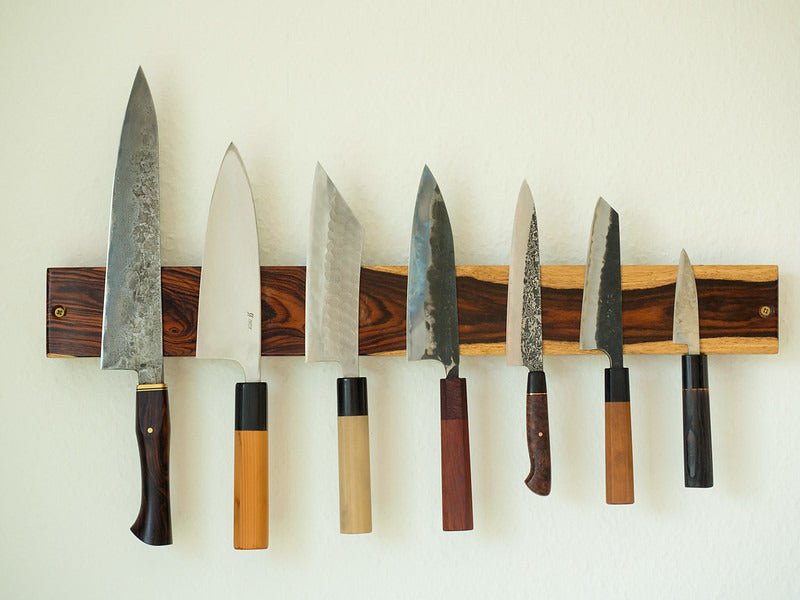Your Cart is Empty
FREE Worldwide Shipping! | +1 365 654 6605
FREE Worldwide Shipping! | +1 365 654 6605
November 11, 2023 6 min read

Knives are an essential tool in every kitchen, and proper maintenance and care are crucial to ensure their longevity and optimal performance. In this comprehensive guide, we will delve into the best practices for knife care, including cleaning, sharpening, and storing your knives. By following these tips, you can keep your knives sharp, safe, and ready to tackle any culinary task. Taking care of your knives is essential for several reasons. Firstly, a well-maintained knife will perform better, allowing you to work more efficiently in the kitchen. A sharp knife provides clean, precise cuts, reducing the chances of accidents compared to using a dull blade. Contrary to popular belief, a dull knife is more dangerous as it requires excessive force and is prone to slipping, potentially causing injuries. Proper cleaning is the first step in knife maintenance. It is crucial to clean your knives promptly after each use to prevent food particles from solidifying and potentially damaging the blade. While it may be tempting to toss your knives in the dishwasher, this should be avoided. High heat and abrasive detergents can dull the blade and damage the handle, especially for knives with wooden handles. Hand-washing is the safest method for cleaning knives. To clean your knives, hold the blade away from you and use a dishcloth or sponge with warm water and mild dish soap. Gently wipe each side of the blade, being careful not to cut yourself. For stubborn food particles, soak the knife in a mixture of hot water and dish soap for a few minutes before wiping it clean. Once cleaned, thoroughly dry the knife to prevent water marks and store it in its designated spot. Maintaining a sharp edge is crucial for optimal knife performance. Honing and sharpening are two different techniques used to maintain the sharpness of a knife. Honing is the process of realigning the edge of the blade, ensuring it remains straight and sharp. This can be done frequently, even before each use, using a honing steel or rod. On the other hand, sharpening involves removing a small amount of metal from the blade to create a new edge. This process is less frequent and typically done once or twice a year. Sharpening can be done using various methods, such as whetstones or electric sharpeners. It is essential to follow the angle recommended by the knife manufacturer to achieve the best results. Knowing when to sharpen your knife is crucial to maintain its effectiveness. There are a few simple tests you can perform to determine if your knife needs sharpening. The paper test is a quick and effective method: hold a sheet of paper in the air and attempt to slice through it. If the knife struggles to cut cleanly through the paper, it is likely dull and in need of sharpening. Another test is the tomato test. Slice through a tomato on a cutting board using your knife. If the blade struggles to pierce the skin smoothly, it indicates that the knife is dull and requires sharpening. Regularly performing these tests will help you identify when your knives need sharpening, allowing you to maintain their performance. Storing your knives correctly is crucial to prevent damage to the blades and ensure safety in the kitchen. Loose knives in drawers pose a risk of cutting yourself when reaching for other utensils. There are several options for storing knives properly: Proper knife storage not only protects the blades but also prolongs their sharpness and lifespan. The choice of cutting surface can significantly impact the sharpness and longevity of your knives. Hard, abrasive surfaces such as stone cutting boards or granite countertops can quickly dull the blade. It is essential to use cutting boards made of materials that are softer than the knife blade itself, such as wood, bamboo, or plastic. Wooden cutting boards, such as those made from larch, teak, or Japanese cypress, are gentle on the blades and provide a forgiving surface. Plastic cutting boards are also a viable option as they can be easily cleaned and replaced when necessary. Avoid using glass, granite, or porcelain surfaces for cutting, as they can damage the knife blade. Here are some additional tips to help you maintain your knives in excellent condition: By following these additional tips, you can further enhance the longevity and performance of your knives. Proper maintenance and care are essential for keeping your knives sharp, safe, and efficient in the kitchen. Regular cleaning, honing, sharpening, and appropriate storage will ensure the longevity and optimal performance of your knives. By following the guidelines outlined in this ultimate knife care guide, you can enjoy the benefits of well-maintained knives for years to come. Remember, a sharp knife is not only a chef's best friend but also a vital tool in creating culinary masterpieces. Invest the time and effort in caring for your knives, and they will reward you with precision, efficiency, and a pleasurable cooking experience. Happy cooking and happy knife care!Section 1: Importance of Knife Care
Section 2: Cleaning Your Knives
Section 3: Honing vs. Sharpening
Section 4: Signs Your Knife Needs Sharpening
Section 5: Proper Knife Storage
Section 6: Choosing the Right Cutting Surface
Section 7: Additional Tips for Knife Care
Section 8: FAQs About Knife Care
Section 9: Conclusion
References
Be the first to know about upcoming sales and promos. Get a 10% discount coupon when you subscribe!